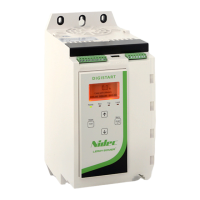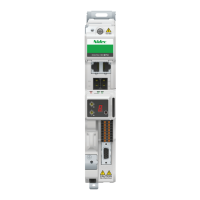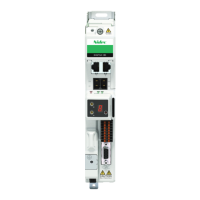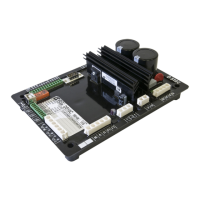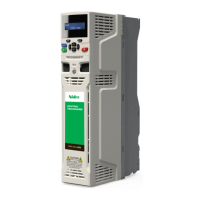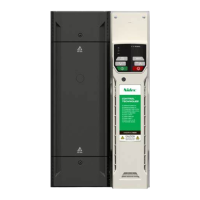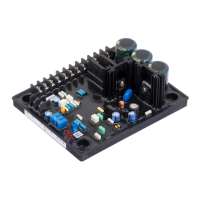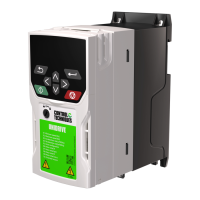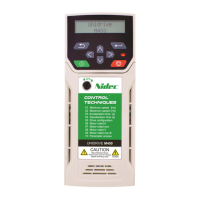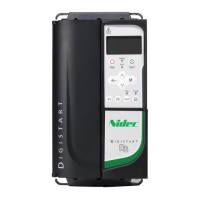
Do you have a question about the Nidec Digistart D3 and is the answer not in the manual?
| Type | Soft Starter |
|---|---|
| Rated Voltage | 200-480VAC |
| Communication | RS485 |
| Enclosure Rating | IP20 |
| Mounting | Panel Mount |
| Control Type | Microprocessor |
| Control Method | Voltage ramp |
| Communication Protocols | Modbus RTU |
| Protection Features | Overload, Phase Loss |
| Protection | Built-in protection features |
| Ambient Temperature | -10°C to +50°C |
Alerts to severe electrical shock and lethal hazards from starter operation.
Ensures safe system design and operation by trained personnel.
Specifies limits for transport, storage, installation, and use of the starter.
Outlines installer responsibilities for adhering to relevant regulations.
Guides motor installation and parameter setup for thermal protection.
Warns against altering parameters without understanding their impact on operation.
Details electrical shock risks, power-up, stored charge, and safe installation practices.
Explains the structure and meaning of the model code for identifying specifications.
Defines AC53b/AC53a codes specifying current ratings based on operating conditions.
Provides physical dimensions (A-I) and weight in kg/lb for various models.
Details spacing requirements for side-by-side mounting and clearance from surfaces.
Step-by-step instructions for adjusting busbars for top or bottom input/output.
Illustrates power input/output configurations for bypassed and non-bypassed models.
Provides a schematic for connecting control voltage, remote inputs, thermistors, and outputs.
Details motor connection methods (in-line, inside delta) and wiring diagrams.
Guides selection of semiconductor and HRC fuses for Type 1 and Type 2 coordination.
Explains when an external bypass contactor is needed and its selection criteria.
Specifies main contactor requirements for inside delta connections and AC3 rating.
Suggests using a shunt trip circuit breaker as an alternative to a main contactor.
Describes using the Digistart D3 to control PFC contactors for power factor correction.
Lists international immunity and emissions standards the Digistart D3 complies with.
Describes the keypad layout, buttons, display, and status LED functions.
Provides instructions on safely removing and reattaching the keypad, even with the starter running.
Explains how the keypad synchronizes parameter settings with the soft starter upon connection.
Details how to view status, performance, and other information on the keypad display.
Outlines basic control wiring connections required for initial setup and operation.
Guides through the Quick Setup Menu for common applications and essential parameter configuration.
Explains how to control the starter using the keypad, remote inputs, or communication links.
Details various soft start methods like Constant Current, Current Ramp, and Adaptive Control.
Describes different motor stop methods including Coast to Stop, TVR Soft Stop, Adaptive Control, and Brake.
Explains how to use the jog function for precise motor positioning and slow-speed operation.
Notes on functions not supported or behaviour changes when operating in inside delta configuration.
Describes how to open and navigate the programming menu to access settings.
Details the use of a four-digit security access code to protect critical parameters.
Explains how to lock parameters to prevent unauthorized changes, setting them to 'Read Only'.
Instructions for restoring all parameters to factory default settings, excluding language.
Provides suggested parameter values for common applications via the Quick Setup Menu.
Outlines access to commonly used parameters for configuring the Digistart D3.
Provides access to all programmable parameters for experienced users.
Details parameters for motor's Full Load Current, Locked Rotor Current, Time, and Service Factor.
Configures soft start methods, current limits, ramp times, and stop modes for the motor.
Defines functions for digital inputs, including start, stop, reset, and programmable inputs.
Configures relay outputs for signalling motor status, trips, and other conditions.
Sets trip points for protection mechanisms like current imbalance, underpower, and overpower.
Adjusts delays for protection responses to avoid nuisance trips from momentary fluctuations.
Configures flags for low/high current and motor temperature, and sets mains reference voltage.
Configures analog inputs for tripping and analog outputs for reporting motor data.
Sets language and configures the user-programmable screen and performance graphs.
Configures automatic reset actions for specific trip categories to minimize downtime.
Defines parameters for a secondary motor set or dual thermal modelling.
Configures start/stop modes, current limits, and profiles for a secondary motor set.
Sets parameters for slip-ring motor control, including ramps, retard, and changeover time.
Configures trip points for RTD/PT100 inputs for temperature monitoring.
Manages access codes, adjustment lock settings, and emergency run parameters.
Explains how the starter responds to protection events (trip, warn, log) based on settings.
Lists common trip messages, their probable causes, and suggested solutions for diagnosis.
Addresses operational issues where the starter may not function as expected without tripping.
Illustrates wiring and parameter settings for using a main contactor with the Digistart D3.
Shows how to wire and use an external bypass contactor controlled by the Digistart D3.
Details wiring and parameter settings for enabling emergency run mode, overriding trips.
Explains how to connect an external trip circuit (e.g., low pressure switch) to stop the motor.
Describes using a zero-speed sensor to control DC brake shut-off at motor standstill.
Details setup for soft braking using forward run and braking contactors for high inertia loads.
Explains configuration for dual speed Dahlander motors using high/low speed and star contactors.
Outlines how to control slip-ring motors using rotor resistance and specific commissioning steps.
Details additional requirements and recommended parts for UL compliant installations.
Advises on safe handling, avoiding damage to components, and checking circuit tightness.
Describes how to measure motor and starter input current using a moving coil ammeter.
Explains how to measure starter input and output power using an electrodynamic instrument.
Guidelines for returning products for exchange, emphasizing original or similar packaging.
Lists available fieldbus communication modules like DeviceNet, Ethernet/IP, Modbus, Profibus, Profinet.
Describes the software for managing soft starter networks, operation, and performance monitoring.
Explains finger guards for personnel safety, providing IP20 protection against terminal contact.
Details the expansion card providing additional digital inputs, output relays, and analog I/O.
Describes the card for RTD/PT100 inputs and ground fault protection, requiring a current transformer.
Information on the kit for remote mounting the keypad up to 3 meters from the soft starter.
